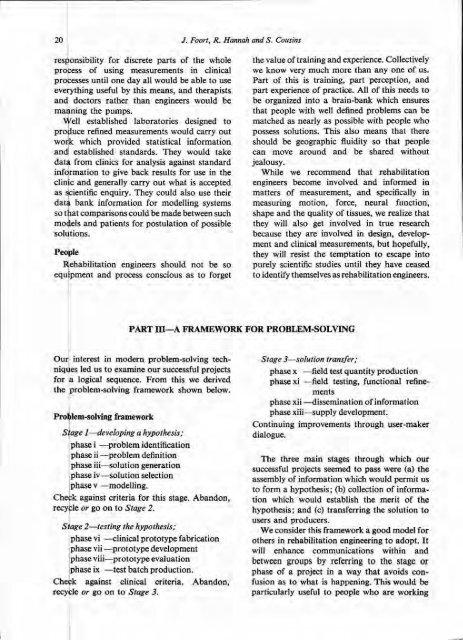Prosthetics and Orthotics
Prosthetics and Orthotics
Prosthetics and Orthotics
Create successful ePaper yourself
Turn your PDF publications into a flip-book with our unique Google optimized e-Paper software.
esponsibility for discrete parts of the whole<br />
process of using measurements in clinical<br />
processes until one day all would be able to use<br />
everything useful by this means, <strong>and</strong> therapists<br />
<strong>and</strong> doctors rather than engineers would be<br />
manning the pumps.<br />
Well established laboratories designed to<br />
produce refined measurements would carry out<br />
work which provided statistical information<br />
<strong>and</strong> established st<strong>and</strong>ards. They would take<br />
data from clinics for analysis against st<strong>and</strong>ard<br />
information to give back results for use in the<br />
clinic <strong>and</strong> generally carry out what is accepted<br />
as scientific enquiry. They could also use their<br />
data bank information for modelling systems<br />
so that comparisons could be made between such<br />
models <strong>and</strong> patients for postulation of possible<br />
solutions.<br />
People<br />
Rehabilitation engineers should not be so<br />
equipment <strong>and</strong> process conscious as to forget<br />
the value of training <strong>and</strong> experience. Collectively<br />
we know very much more than any one of us.<br />
Part of this is training, part perception, <strong>and</strong><br />
part experience of practice. All of this needs to<br />
be organized into a brain-bank which ensures<br />
that people with well defined problems can be<br />
matched as nearly as possible with people who<br />
possess solutions. This also means that there<br />
should be geographic fluidity so that people<br />
can move around <strong>and</strong> be shared without<br />
jealousy.<br />
While we recommend that rehabilitation<br />
engineers become involved <strong>and</strong> informed in<br />
matters of measurement, <strong>and</strong> specifically in<br />
measuring motion, force, neural function,<br />
shape <strong>and</strong> the quality of tissues, we realize that<br />
they will also get involved in true research<br />
because they are involved in design, development<br />
<strong>and</strong> clinical measurements, but hopefully,<br />
they will resist the temptation to escape into<br />
purely scientific studies until they have ceased<br />
to identify themselves as rehabilitation engineers.<br />
PART III—A FRAMEWORK FOR PROBLEM-SOLVING<br />
Our interest in modern problem-solving techniques<br />
led us to examine our successful projects<br />
for a logical sequence. From this we derived<br />
the problem-solving framework shown below.<br />
Problem-solving framework<br />
Stage 1—developing a hypothesis;<br />
phase i —problem identification<br />
phase ii —problem definition<br />
phase iii —solution generation<br />
phase iv —solution selection<br />
phase v —modelling.<br />
Check against criteria for this stage. Ab<strong>and</strong>on,<br />
recycle or go on to Stage 2.<br />
Stage 2—testing the hypothesis;<br />
phase vi —clinical prototype fabrication<br />
phase vii —prototype development<br />
phase viii —prototype evaluation<br />
phase ix —test batch production.<br />
Check against clinical criteria. Ab<strong>and</strong>on,<br />
recycle or go on to Stage 3.<br />
Stage 3—solution transfer;<br />
phase x —field test quantity production<br />
phase xi —field testing, functional refinements<br />
phase xii —dissemination of information<br />
phase xiii —supply development.<br />
Continuing improvements through user-maker<br />
dialogue.<br />
The three main stages through which our<br />
successful projects seemed to pass were (a) the<br />
assembly of information which would permit us<br />
to form a hypothesis ; (b) collection of information<br />
which would establish the merit of the<br />
hypothesis; <strong>and</strong> (c) transferring the solution to<br />
users <strong>and</strong> producers.<br />
We consider this framework a good model for<br />
others in rehabilitation engineering to adopt. It<br />
will enhance communications within <strong>and</strong><br />
between groups by referring to the stage or<br />
phase of a project in a way that avoids confusion<br />
as to what is happening. This would be<br />
particularly useful to people who are working

















